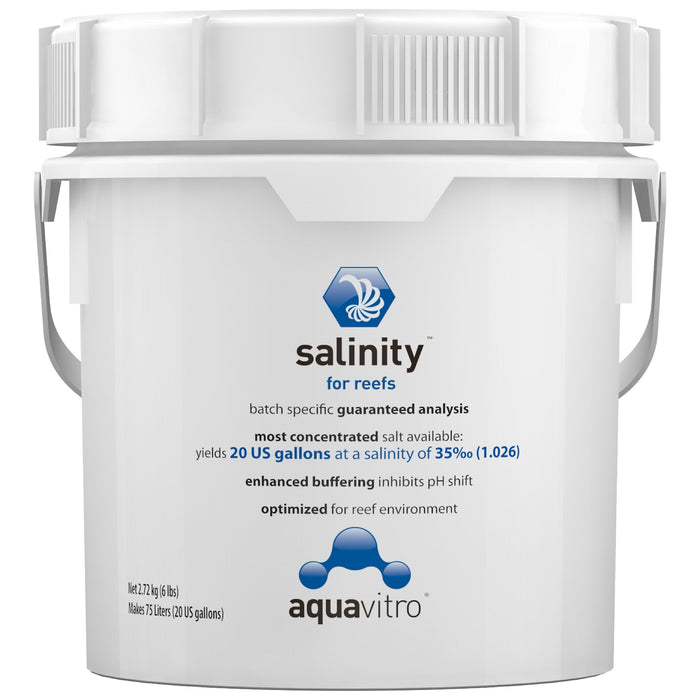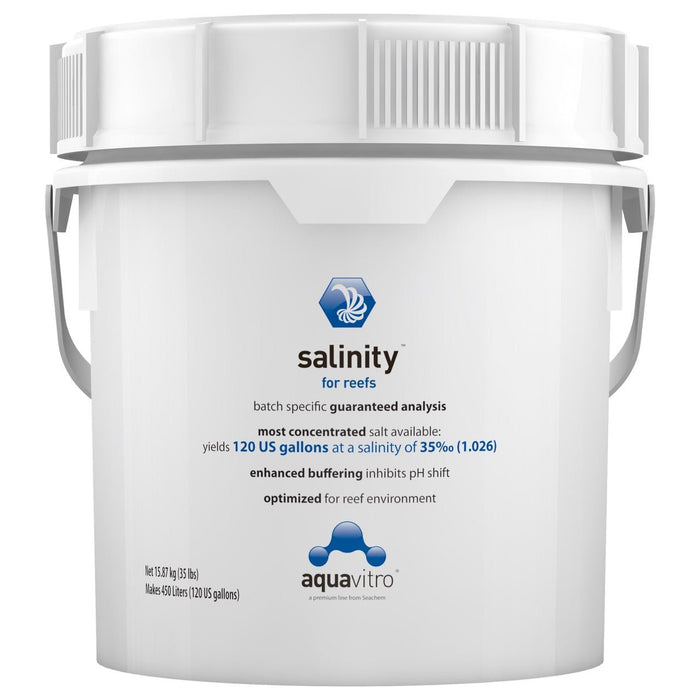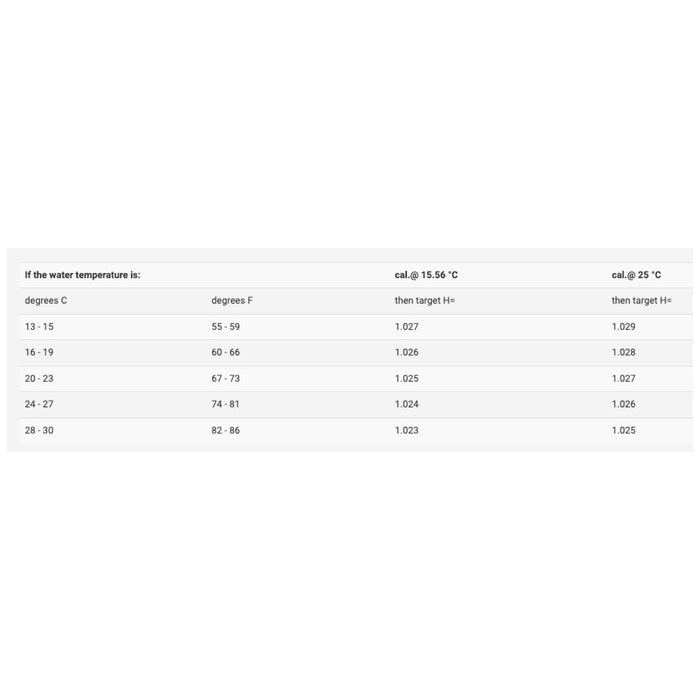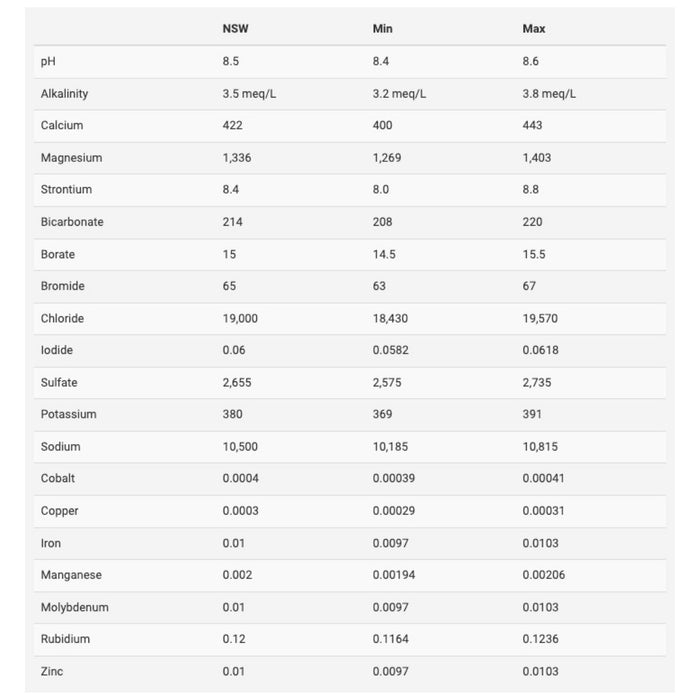Aquavitro Salinity Reef Salt
- Most concentrated salt available
- Batch-specific guaranteed analysis
- Enhanced buffering inhibits pH shift
salinity™ is a blend of salts specifically formulated for the reef aquarium that contains all essential major, minor, and trace components found in natural reef waters, but contains no toxic or non-essential components. Additionally, salinity™ is the most concentrated salt blend on the market. With a hydration level of <0.5% salinity™ will yield a greater volume of prepared saltwater at a salinity of 35‰ per unit of weight than any other salt mix currently on the market.
salinity™ is identical to the distribution of anions and cations found in Natural Sea Water (NSW). We have compiled data from all the oceans and seas on the Earth, and have targeted the midpoint of the range for each element. We guarantee to be within ± 5% of the midpoint.
At a salinity of 35‰, for calcium, magnesium, strontium, pH, and alkalinity we have the following targets and/or ranges (see right).
Calcium
Target 422 mg/L, range 400–443 mg/L
Magnesium
Target 1336 mg/L, range 1269–1403 mg/L
Strontium
Target 8.4 mg/L, range 8.0–8.8 mg/L
pH
Range 8.4–8.6
Alkalinity
Range 3.2–3.8 meq/L
Sizes:
2.72 kg (6 lbs) Makes 75 liters (20 US gallons),
15.87 kg (35 lbs) Makes 450 liters (120 US gallons),
29.75 kg (65.5 lbs) Makes 850 liters (225 US gallons)
Directions:
Mix salinity™ with dechlorinated tap or purified water. We recommend the use of a commercial dechlorinator like alpha™ to neutralize any tap water chlorine and/or chloramines. If source water quality is poor we recommend purification with a Seachem Pinnacle™ RO/DI system. To prepare small quantities, add 36 grams per 1 liter of water. [This is a little less than 1/2 cup of salt per US gallon of water. For 15 gallons use 7 cups of salinity™.]
Stir well to ensure a good mix. Although the salinity™ solution may be used immediately, we suggest mixing for 6-10 hours to achieve oxygen/carbon dioxide equilibrium.
Measure the salinity. We recommend a salinity of 35‰. This will be a temperature compensated SG (specific gravity) value of 1.026. If you are using uncorrected SG values (H) then the following formula will yield a value for S (salinity) accurate to within 1%:
S = [0.3348 * T] + [1325 * H] - 1330.4525 (calibrated at 15.56 °C (60 °F))
S = [0.2211 * T] + [1325 * H] - 1330.4525 (calibrated at 25 °C (77 °F))
where S is the salinity in parts per thousand; T is temperature in degrees centigrade (range of 13-30 °C); and H is the uncorrected hydrometer reading. If you don't mind an error on the order of ±3%, simply use the attached table.
Adjust salt level accordingly. If salinity is too low, then add more salinity™. If too high, add more water.
Change 20% of aquarium water every two weeks (or as necessary) to maintain optimum water quality.
USAGE NOTE: NEVER mix salt in an aquarium containing livestock. Transfer livestock to the aquarium AFTER salt is completely mixed and specific gravity has been adjusted. Use Seachem's Stability® to avoid "new tank syndrome" and to prevent unnecessary livestock losses in a new system.
Batch Guarantee
Every bucket of salinity™ comes with a laboratory tested*, batch specific guaranteed analysis. We guarantee that salinity™ will have a guaranteed analysis that falls within the ranges below.
(* EPA Standard Method 6010)
FAQ:
When I mix salinity salt in my water barrel using a pump and a heater I get cloudy water. What is happening?
A: Because of the mineral content in salinity, it is possible to get some precipitant in the bottom of the mixing container. The residue that is left in the container is a direct result of a few things:
1. The highly concentrated materials used in the salt
2. Letting it mix too long/ or at a speed that is too rapid
3. A natural occurrence when mixing a high quality salt
When mixing this salt, we have found that 24 hours or less is ideal (more specifically 6-10 hours is best). The longer you let the salt mix, the more CO2 it will take on and the more precipitation you will encounter. CO2 --> water --> carbonic acid --> bicarbonates/carbonates. Mixing the salt for more than 24 hours can cause a decrease in alkalinity and pH, resulting in a precipitation of calcium and carbonates. When we mix it here at Seachem, we mix it in 50 gallon drums with one power head at room temperature (22-25 degrees Centigrade). There is no need to use a heater or multiple power heads. As a matter of fact, we do not recommend using a heater or powerful circulation when mixing Salinity. Typically the water is clear within a few hours but sometimes we have to use it within an hour of mixing, when it is still cloudy. This cloudiness clears rapidly once introduced to the tank, generally within 30 minutes, and will not cause any harm to the inhabitants. Furthermore, cloudiness seems to persist more with buckets that have calcium and alkalinity levels on the higher end of the range. This is really inevitable when you have such high levels of those particular components. I would recommend that you check the strength of the pump and reduce it if necessary, and to hold off on using the heater until the mixing process is complete as the heated water will create higher likelihood of precipitation.
I am mixing my saltwater to 1.025 specific gravity. Your label guarantees 410 mg/L for calcium but when I test, I only get 385 mg/L. Am I doing something wrong?
A: When our batch samples are sent off to the lab to be analyzed, the guaranteed values are at a salinity of 35 ppt. We do not use the measurement of specific gravity because this measurement is temperature dependent. While your specific gravity is 1.025, this does not mean that your salinity is up to 35 ppt. It is best to use a temperature compensated refractometer and measure in terms of ppt in order to achieve accurate parameters.
Safety
CAUTION: SALINITY™ IS NOT FOR HUMAN CONSUMPTION. KEEP OUT OF REACH OF CHILDREN. Contact in dry form may cause skin or eye irritation. In case of eye contact, completely flush eye(s) with cool water and seek medical attention.








